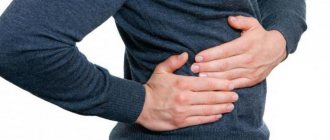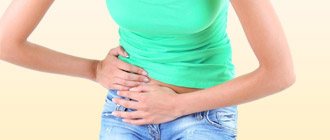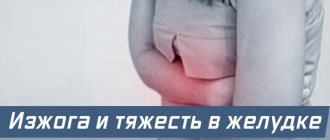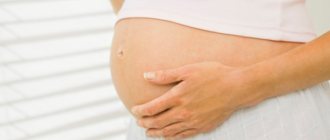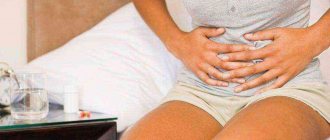12/06/2018 Category: Diseases and complications Author: Valentina Zykova
Pulling, stabbing or sharp pain in the abdomen during pregnancy causes discomfort and anxiety in expectant mothers. Pregnant women worry not only about their health, but also about the safety of their baby. To eliminate the problem, it is necessary to conduct a diagnosis - determine the location and nature of the pain.
- Etiology of pain in the right side of the abdomen
Video: causes of abdominal pain during pregnancy - Pressure of the uterus on the abdominal organs, active fetal movements in the later stages
- Uterine tone
- Difficulty having bowel movements
Video: perinatal psychologist, expert on preparation for childbirth Natalya Genovna Maraleva about exercise to stimulate the intestines in a pregnant woman
- Diaphragm diseases
Pancreatitis
- Dyskinesia of the gallbladder and bile ducts
- Hepatitis
- Video: nephrologist, doctor of the highest category about kidney diseases during pregnancy
- Table: treatment of a woman depending on the cause of pain
Abdominal organs of the right hypochondrium, lateral and iliac regions
The human torso is conventionally divided into two parts: the chest and abdomen. The belly is divided into nine parts.
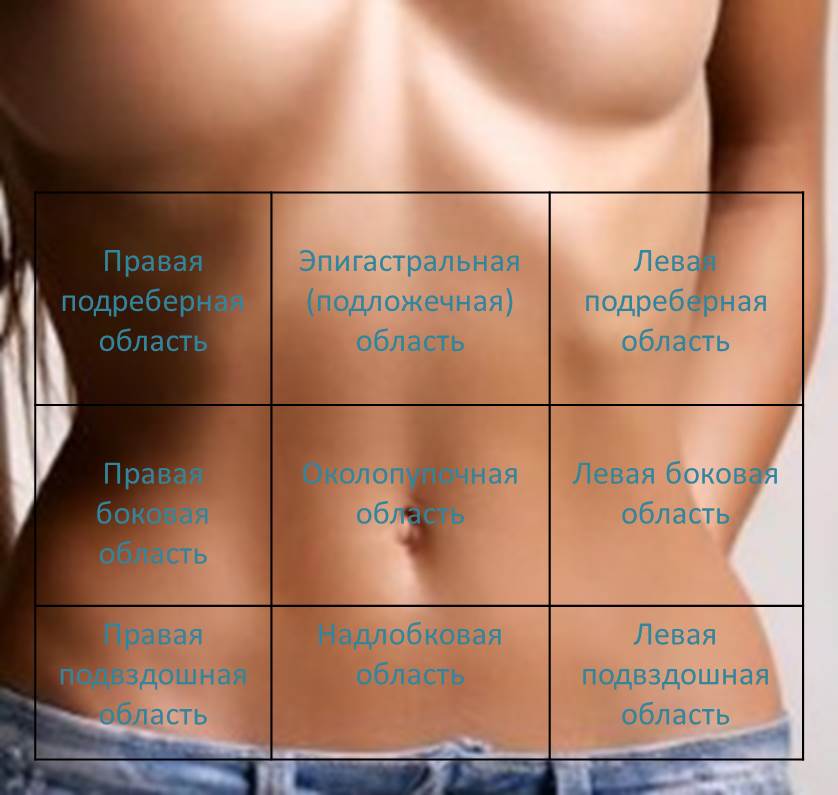
The abdomen is conventionally divided into 9 regions
Abdominal organs on the right:
- in the subcostal region:
- the right lobe of the liver and partially its left lobe;
- the upper part of the right kidney with the adrenal gland;
gallbladder with excretory ducts for bile;
- ascending colon;
- ileum and cecum with appendix;
- transition of the stomach to the duodenum;
Etiology of pain in the right side of the abdomen
During pregnancy, the internal organs work in an intensive mode and provide the fetus growing inside the woman with everything necessary. But due to increased loads, disruptions occur in their work, which the body immediately signals with pain.
Video: causes of abdominal pain during pregnancy
The causes of abdominal pain may not pose a health hazard and are within normal limits during pregnancy. But to be completely sure, it is recommended to consult a doctor.
Pressure of the uterus on the abdominal organs, active fetal movements in the later stages
The third trimester of pregnancy is characterized by accelerated growth in the size and weight of the child, and therefore an enlarged uterus.
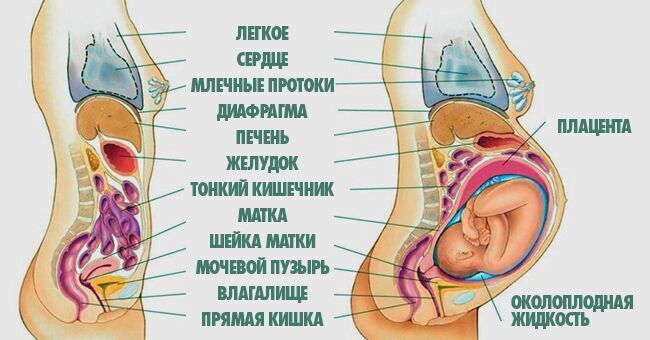
An enlarged uterus shifts the surrounding organs relative to their normal position
The fetus is already active, its chaotic and strong movements lead to compression of internal organs and nerve endings. What does this lead to:
- To pinching of the ureters. Squeezing of small channels leading urine from the kidney to the bladder provokes problems with urination.
- To the appearance of heartburn. Digestion and the functional speed of food movement through the digestive tract are disrupted, and due to hormonal softening of the sphincter muscles (the muscles at the border of the esophagus and stomach), bile is thrown back from the stomach into the esophagus.
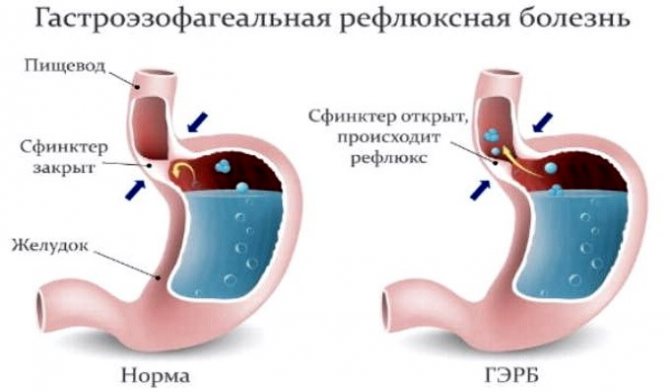
Bile, its acids and salts damage the inner lining of the organ - To short-term pain caused by stretching of the uterine ligaments. In this case, there is no threat to health and there is no need for special treatment.
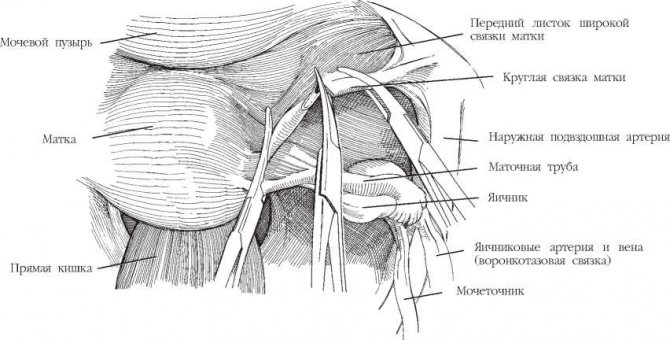
Physiologically, the right uterine ligament is shorter than the left and therefore hurts from overexertion more often, especially if the embryo is attached to the right side
Uterine tone
According to statistics, increased uterine tone is diagnosed in 60% of pregnant women. This is a physiological phenomenon - at the beginning of pregnancy, the uterus reacts with increased tone to the attachment of the fertilized egg to it and to any nervous experiences of the expectant mother, and in the last trimester - this is muscle training for successful delivery. Symptoms of uterine tone are visible even upon visual examination: the abdomen becomes hard and dense, the uterus rises slightly, and stands up like a stake. Sometimes uterine tone is asymptomatic, or the woman may not feel them. Doctors distinguish 2 degrees of tone:
- 1st degree is accompanied by slight nagging pain in the lower back, heaviness in the sacrum, back, and aching in them;
- Stage 2 is characterized by pain going down to the lower abdomen, as during menstruation, and there may be a feeling of fullness in the external genitalia. A pregnant woman often visits the toilet due to constant urge.
Difficulty having bowel movements
Constipation is a disorder of the bowel movement, characterized by the absence of stool for more than 48 hours or insufficient bowel movements. Divided into two types:
- dense, dry feces, shaped like small balls, beans, or a cord, with a frequency of once every 2-3 days or less. The process of defecation is painful and lengthy;
- constipative diarrhea with an admixture of mucus formed due to irritation of the intestinal walls by stagnant feces.
How can you tell if you are constipated? Its signs:
- intestinal spasm. Accompanied by pain and heaviness in the abdomen, relieved after bowel movements and release of intestinal gases;
- a feeling of distension, fullness of the intestines even after defecation due to the accumulation of gases;
- pain in the sacrum when pushing;
- lack of appetite, bad breath, belching air;
- bad mood, fatigue, sleep disturbance.
Video: perinatal psychologist, expert on preparation for childbirth Natalya Genovna Maraleva about exercise to stimulate the intestines in a pregnant woman
Constipation causes the development of intestinal dysbiosis, chronic colitis, contributes to poisoning of the body, the appearance of cracks in the irritated intestinal mucosa, inflammation of hemorrhoidal veins and even hernia. In addition, innocent constipation can, due to increased pressure on the muscles of the abdominal wall and provoked uterine tone, cause premature birth.
Ectopic pregnancy
Having barely seen the faint second line on the test, the woman rejoices at the arrival of the long-awaited pregnancy. But we do not suspect that nausea, weakness, dizziness and spasmodic pain in the lower abdomen can also be signs of an ectopic pregnancy.
An ectopic pregnancy is a pregnancy characterized by the attachment and development of the fertilized egg outside the uterus - in the abdominal cavity, ovary, or fallopian tube. The fertilized egg, increasing in size by the 5th–6th week of pregnancy, leads to rupture of the organ that sheltered it.
Signs of an ectopic pregnancy:
- brownish-bloody, spotting vaginal discharge;
- low blood pressure with increased heart rate, foggy consciousness, weakness;
- pale skin;
- nagging pain in the lower abdomen, extending into the anus, legs or lower back;
- swelling of the mammary glands;
- nausea, vomiting, lack of appetite.
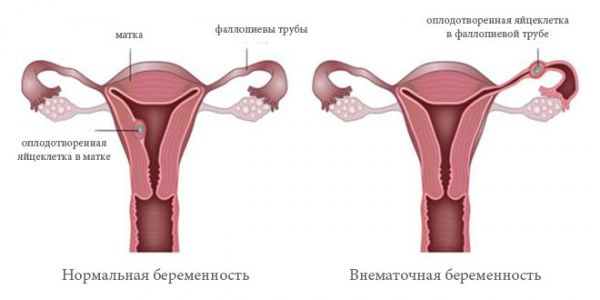
Tubal pregnancy, diagnosed in 97.7% of cases, is characterized by the location of the fertilized egg in the fallopian tube
Ovarian cyst
An ovarian cyst is a benign tumor.
Most cysts “grow” asymptomatically, but with a significant increase in size, the cyst will manifest itself with the following symptoms:
- regular aching pain (mainly due to the development of complications: torsion of the cyst leg, rupture of the membrane, bleeding or suppuration), radiating to the anus;
- asymmetry of the abdomen on the part of the enlarged tumor;
- constipation and frequent unsuccessful urge to defecate, pain when urinating;
- varicose veins in the legs;
- increased body temperature with simultaneous vomiting.
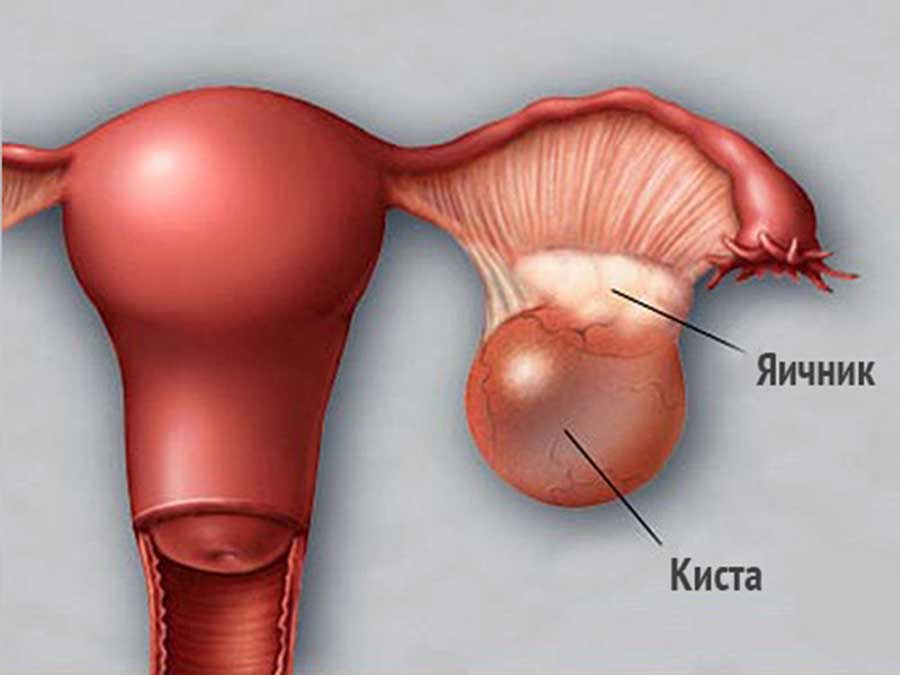
An ovarian cyst is a formation in the form of a bubble with liquid or semi-liquid contents that appears in the structure of the ovary and increases its volume several times
Renal colic
Renal colic is an acute painful attack caused by impaired passage of urine through the urethra, increased pressure in the renal pelvis and insufficient blood supply to the kidney. For adequate treatment, it is important to correctly diagnose the disease. The symptoms are similar to inflammation of the appendix, pancreas with pancreatitis, gall bladder with cholecystitis, as well as ectopic pregnancy. Renal colic will manifest itself:
- sudden severe pain that arises and quickly fades in the lower back, descending to the groin area down to the perineum. The pain does not subside when changing body position, lasts from 3 to 18 hours and is especially disturbing at night;
- frequent urination of small amounts of blood;
- intestinal disorders, dry mouth;
- pale skin, chills with cold sweat, high blood pressure.
Intestinal obstruction
Early symptoms of volvulus - persistent constipation - are often ignored, since pregnant women tend to endure pain during bowel movements. Intestinal obstruction is a deterioration in the passage of stool or complete blockage of the intestines with solid stool.
With intestinal obstruction, there is an acute, cramping pain that moves to the right side or to the lower abdomen. Over the next two hours, other signs are added:
- with a complete lack of appetite, frequent vomiting (due to excessive fullness of the duodenum);
- false urge to urinate and pain due to frequent intestinal contractions, rarely diarrhea or loose stools with blood;
- the pulse quickens and the blood pressure decreases;
- the skin is pale, “cold” sweat often appears;
- the temperature with intestinal obstruction is normal;
- the tongue becomes covered with a white coating.
During pregnancy, there are three periods that are considered critical in terms of the chances of developing intestinal obstruction:
- rise of the uterine fundus by the end of the first trimester;
- drooping of the fetal head at the end of pregnancy;
- sudden contraction of the uterus after childbirth.
Often at the end of pregnancy, cramping pain due to intestinal obstruction is confused with prenatal contractions. In case of these pains, it is recommended to consult a doctor, who, upon examination in a gynecological chair, will determine whether the woman is in labor or not. When the disease is neglected, peritonitis (inflammation of the peritoneum) occurs.
Protrusions in the lumbar spine
Intervertebral disc protrusion is the first stage in the development of intervertebral herniation as a result of the disc protruding beyond the boundaries of the spinal column. In pregnant women it develops due to limited mobility or scoliosis.
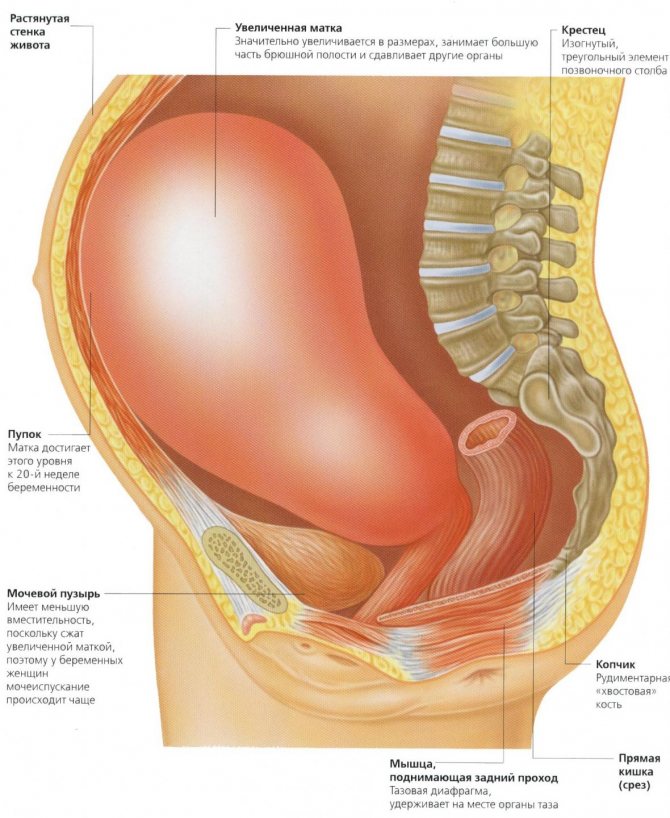
The growing uterus puts more and more pressure on the spine every week, which leads to increased pain in the lumbar region
In the third trimester of pregnancy, hormonal changes begin in the body of the expectant mother with increased production of the hormone relaxin, which relaxes the muscles of the spinal column and pelvis, which accelerates disc protrusion and leads to a hernia. And the hormone progesterone helps him in this, pushing blood to the vessels of the spine and increasing the swelling of tissues and nerve endings. If you do not control the condition of the diseased disc, then during labor it may become pinched during labor.
A pregnant woman should be prompted to consult a neurologist to examine possible hernias and protrusions by the following signs:
- stiffness of movement in the lumbar spine, pain increases with movement and coughing;
- when moving, the pain radiates to the right side of the back or goes down below the tailbone;
- In the area of pain, tingling appears, stiffening of the muscles up to lameness.
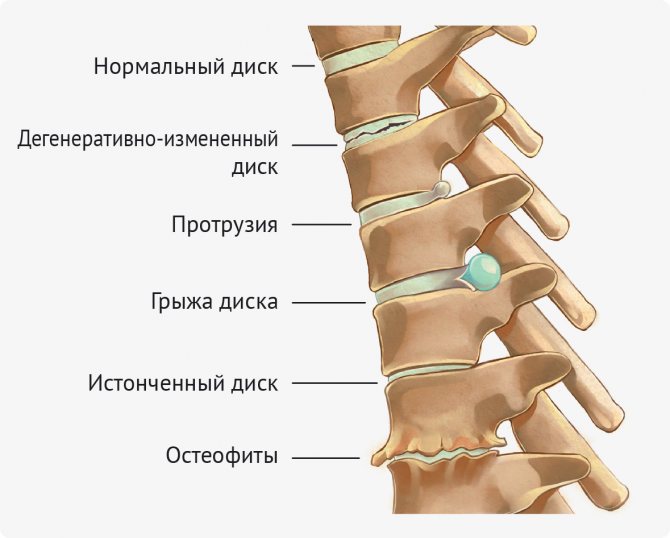
The protrusion itself does not complicate the course of pregnancy and is not an indication for surgical delivery with proper monitoring of the condition of the spine.
Appendicitis
When there is pain in the lower right side, the first thing that comes to the doctor’s mind is inflammation of the vermiform appendix of the cecum (appendix).
It is not necessary that appendicitis will immediately manifest itself with acute pain radiating to different parts of the abdomen or back. Initially, it is a weak dull pain in the right upper abdomen, or in an atypical location - in the left. Then the pain increases and moves to the source of inflammation (10–15 centimeters to the right of the navel). You can localize the place of its occurrence with one finger.
Inflammation of this process will manifest itself with the following symptoms:
- a sudden “lumbago” of a different nature (pulling, cutting, aching or stabbing), intensifying when turning from one side to the other and coughing. The pain is especially severe when lying on the right side;
- low-grade fever;
- prolonged nausea, sometimes vomiting, diarrhea;
- defecation delay. The patient feels the urge to defecate, but visiting the toilet does not bring relief;
- normal color of stool with a slight admixture of mucus (due to intoxication);
- coating on the tongue of a yellowish tint (in acute form - dry);
- general excited state.
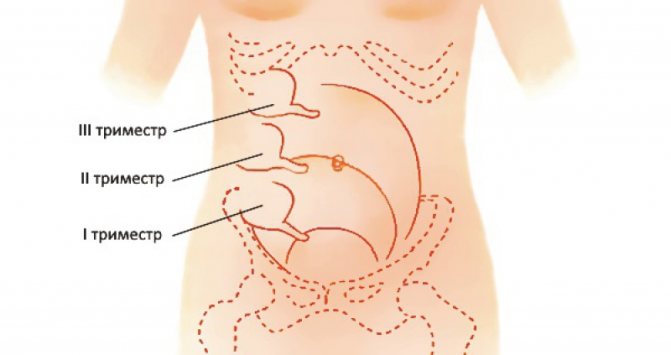
With appendicitis, an “acute abdomen” syndrome is possible, in which an ambulance is immediately called and mentally prepared for surgery. If complications develop, delay can cost the pregnant woman her life: after just a couple of days, appendicitis goes into the gangrenous stage, which ends in a breakthrough, which provokes peritonitis.
Venereal diseases
Gonorrhea, genital herpes, HIV or AIDS, chlamydia and trichomoniasis also cause pain in the lower abdomen or right side. It is worth seeing a doctor and getting tested for infections to reduce the risk of infection of the baby in the womb or to avoid miscarriage, premature rupture of membranes and untimely birth.
The doctor will prescribe antibiotics approved for use by pregnant women and select the necessary treatment to prevent relapse.
36th week of pregnancy: fetal development, weight, movement
Another week is over. The child’s body weight increases to 2800 grams, and he manages to grow another centimeter or so in length. The baby's volume has also become larger: the diameter of the head is up to 87.7 mm, the chest - 91.8, tummy - 94.8 mm. Naturally, by this time one can judge the individual size of the child. In many ways, genetic factors are now being guessed. The baby became round, its skin smoothed out. The original lubricant remained only on the tummy and in the folds. Hair, eyebrows, eyelashes - everything has already formed, and even the color of the hairs on the head. One of the factors determining full term is cartilage density. So at this time they became much denser, the ear already has a complex structure. The number of movements of the baby should fit into the same norms as before - one or two movements every quarter of an hour. Although it seems to you that the baby has become calmer. The reason is that now he is simply cramped in the uterus. He has long been positioned in the way that would be most convenient for him to be born - with his head towards the entrance to the pelvis. The child's heart beats at a frequency of 140 beats every minute. The blood vessels and respiratory system are quite ready for autonomous existence. The substance that is necessary to fill the alveoli - surfactant - has accumulated in sufficient quantities. But the placenta gradually dries out. Its thickness has been increasing all this time, so it now reaches 35.59 mm. But it still fulfills its task, delivering nutrients and oxygen to the child. If the blood supply to the placenta rapidly deteriorates, there is a risk of oxygen starvation of the fetus. Which is unacceptable, as it could even lead to his death. Therefore, it is so important to constantly monitor the child’s condition by counting movements.
Pain in the upper segment of the right side

? Pain in the upper right segment of the abdomen can be caused by diseases:
- liver (fatty hepatosis, hepatitis);
- gallbladder (severe attack of pain due to inflammation, the presence of stones, bending of the bile ducts, excess bile, poor functioning of the sphincter that releases bile, rare pain due to a violation of the diet);
- upper right part of the diaphragm (hernia);
- the right part of the intestine with the duodenum (ulcer);
- the upper part of the right kidney with the adrenal gland.
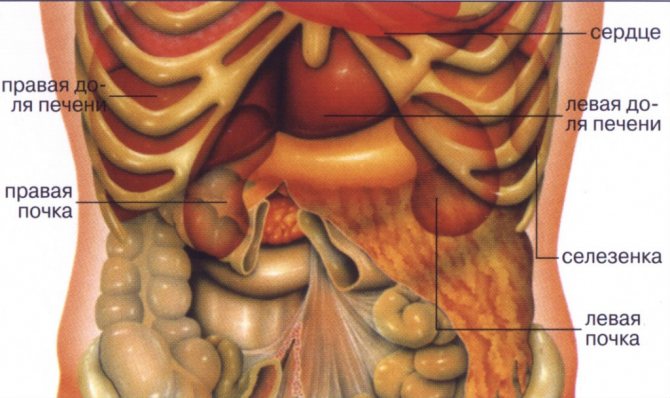
Heartburn can be caused by hepatic or renal colic
Diaphragm diseases
The most commonly diagnosed hernia is diaphragmatic hernia. The uterus that has squeezed the diaphragm, frequent coughing or even constipation contribute to the development of the disease, which is confirmed by examining the esophagus using a flexible endoscope - esophagogastroscopy. Its symptoms:
- pain in the upper hypochondrium, aggravated in a horizontal position and with sharp bending of the body;
- intestinal disorders in the form of vomiting and burning in the esophagus, gas formation, frequent regurgitation;
- increased salivation;
- anemia.
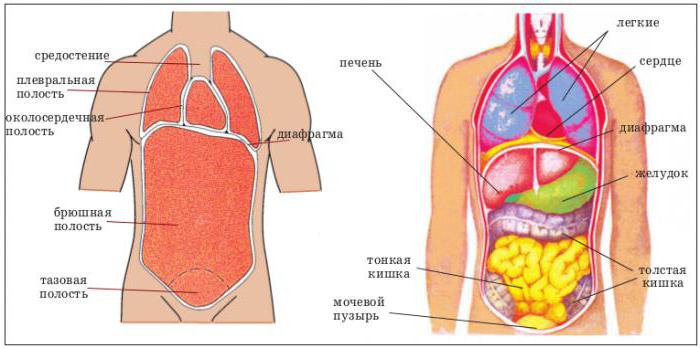
If the hernia is sliding, then it does not pose any harm to the child and is treated with diet and gentle medications, and if the hernia is strangulated, an urgent operation is required to eliminate it.
Pancreatic diseases
The pancreas (or pancreas) is an organ of the digestive system that produces juice with enzymes for digesting food and hormones for metabolism, including insulin.
Pancreatitis
In case of sudden attacks of pain that instantly arises and rolls down the back, it is recommended to pay attention to the pancreas. Inflammation of this organ manifests itself as follows:
- the attack is unbearably painful, with frequent vomiting and profuse sweating;
- the pain begins in the upper quadrant of the abdomen, but then, as if taking it in a ring, it encircles. It intensifies when taking a horizontal position, and subsides if you sit down and lean forward slightly;
- the stomach is swollen from accumulated gases;
- frequent stool discharge, which is not formed and contains particles of undigested food;
- against the background of irritable intestines, dysbiosis with accompanying skin rashes and candidiasis.
Gallbladder diseases
The most common dyskinesia of the gallbladder and ducts and cholelithiasis occur in pregnant women.
Dyskinesia of the gallbladder and bile ducts
Biliary dyskinesia is a disease associated with stagnation of bile due to compression of the bile ducts by the enlarged uterus. Manifests:
- pain in the right hypochondrium;
- esophageal disorders (repeated belching, dryness and bitterness in the throat, burning in the chest, feeling of fullness);
- decreased appetite;
- increased nervousness.
If left untreated, it will lead to inflammation of the gallbladder (cholecystitis) and stone formation (cholelithiasis).
Gallstone disease (cholelithiasis)
Gallstone disease is a violation of the functional movement of bile and cholesterol or bilirubin metabolism with the formation of stones (calculi) in the bile ducts and gallbladder. Pain is caused by poor diet, nervous exhaustion, or prolonged work with a bent back. Characteristic features:
- single, pulsating pain sensations reach their peak during the first hour due to biliary or hepatic colic. A barely bearable attack of pain lasts about six hours, then gradually fades away to a state of aching pain, which can continue for a long time;
- pain follows a path from the abdomen to the back or down the arm from the right shoulder;
- in the acute stage, vomiting and fever.
Liver diseases
If the pain is constant and does not subside, then this may be due to liver or intestinal diseases.
Hepatitis
Pain in the right quadrant of the abdomen during inflammation of the liver - hepatitis A, B, C, sometimes manifests itself only towards the equator of pregnancy, when the woman’s body is weakened and susceptible to infection through water or products due to viral hepatitis A. It is easy to diagnose:
- urine turns brown, skin turns red or yellow (jaundice);
- signs of a viral infection appear: chills, weakness, lack of appetite.
Fatty liver
More often develops towards the end of the second trimester of pregnancy and manifests itself:
- itching of the skin, sometimes jaundice;
- frequent nausea;
- lack of appetite;
- drowsiness;
- sudden change in mood;
- convulsions up to loss of consciousness.
In this case, we are talking about a real threat to the health of the unborn child and his mother, so the woman requires urgent resuscitation care.
Liver colic
The liver moves sideways and upward relative to its normal position and cannot cope with the outflow of bile. Sometimes such short attacks of pain are caused by the child, hitting the expectant mother’s liver. Such pain occurs most often after a diet violation in women with a weakened gallbladder. Unlike painful attacks of appendicitis, during which the pain radiates more to the groin, the liver hurts in the area of the right hypochondrium, and does not allow you to take a deep breath. If you have low-grade body temperature with sudden onset of intestinal disorders, you should seek help from a doctor.
Kidney diseases
With an inflammatory process in the right kidney, the pain will accumulate on top of the abdomen, radiating under the ribs. Often it can “escape” to the perineum in wave-like attacks.
Video: nephrologist, doctor of the highest category about kidney diseases during pregnancy
The danger of nephritis (kidney inflammation) lies in its ability to lead to kidney failure, which requires comprehensive treatment.
Nephritis of the right kidney
If the right kidney becomes infected, pus or stones form in it, which, when leaving the kidney, descend into the ureter and provoke repeated wave-like attacks of pain, targeting the groin.
In acute nephritis, a woman experiences the following symptoms:
- chilling and sweating, dry mucous membranes with subsiding thirst;
- body temperature reaches 40 degrees, increased blood pressure, sometimes dizziness;
- pain with frequent urination;
- puffiness of the face due to the accumulation of fluid in the body, which the kidneys cannot cope with;
- vomiting even without eating;
- increased pain in the lower back when tapping in the area of the projection of the kidneys;
- flakes and sat in the urine.
36th week of pregnancy: nutrition for a pregnant woman
Now you can't do active movements. If you go out somewhere, it’s not for long. Therefore, you should not spend this time eating. There is no need for you to gain sudden weight right now. And although you should eat more often, let it be less calorie food than before. The main thing is that it is rich in nutrients, because your child still needs them for full development. And not just in the womb. For the next few months, his health still depends on you. No matter how hard they try to surprise you, give up exotic and previously untried products for now. It is possible that some of them may cause an allergy. It’s better to be patient and limit yourself to a proven list of your favorite vegetables and fruits. Again, don't get carried away with vacuum-sealed foods. Or carefully check the date of their manufacture. The same goes for raw milk and raw water. Be attentive and careful.
